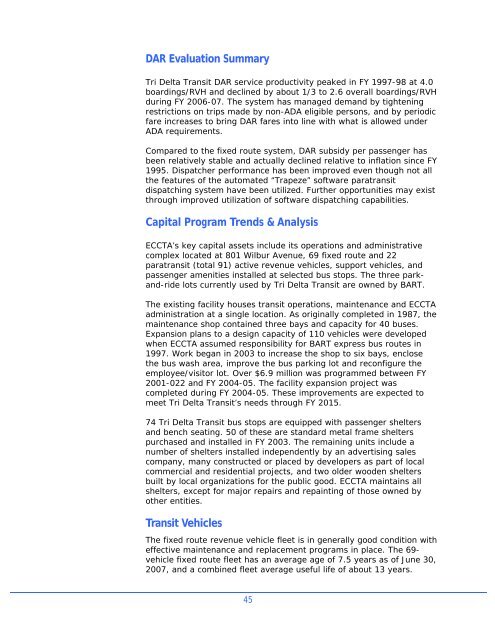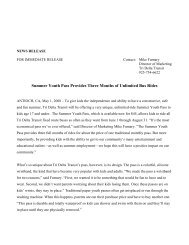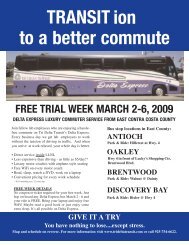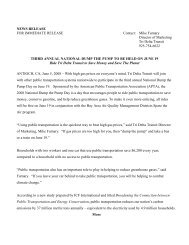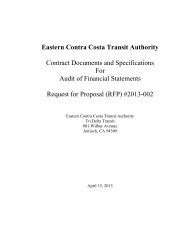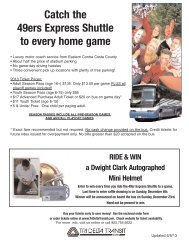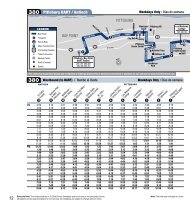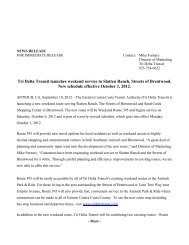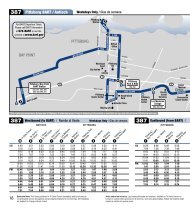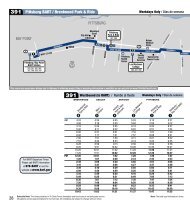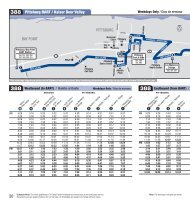to view Short Range Transit Plan FY 2007/2008 - Tri Delta Transit
to view Short Range Transit Plan FY 2007/2008 - Tri Delta Transit
to view Short Range Transit Plan FY 2007/2008 - Tri Delta Transit
Create successful ePaper yourself
Turn your PDF publications into a flip-book with our unique Google optimized e-Paper software.
DAR Evaluation Summary<strong>Tri</strong> <strong>Delta</strong> <strong>Transit</strong> DAR service productivity peaked in <strong>FY</strong> 1997-98 at 4.0boardings/RVH and declined by about 1/3 <strong>to</strong> 2.6 overall boardings/RVHduring <strong>FY</strong> 2006-07. The system has managed demand by tighteningrestrictions on trips made by non-ADA eligible persons, and by periodicfare increases <strong>to</strong> bring DAR fares in<strong>to</strong> line with what is allowed underADA requirements.Compared <strong>to</strong> the fixed route system, DAR subsidy per passenger hasbeen relatively stable and actually declined relative <strong>to</strong> inflation since <strong>FY</strong>1995. Dispatcher performance has been improved even though not allthe features of the au<strong>to</strong>mated “Trapeze” software paratransitdispatching system have been utilized. Further opportunities may existthrough improved utilization of software dispatching capabilities.Capital Program Trends & AnalysisECCTA’s key capital assets include its operations and administrativecomplex located at 801 Wilbur Avenue, 69 fixed route and 22paratransit (<strong>to</strong>tal 91) active revenue vehicles, support vehicles, andpassenger amenities installed at selected bus s<strong>to</strong>ps. The three parkand-ridelots currently used by <strong>Tri</strong> <strong>Delta</strong> <strong>Transit</strong> are owned by BART.The existing facility houses transit operations, maintenance and ECCTAadministration at a single location. As originally completed in 1987, themaintenance shop contained three bays and capacity for 40 buses.Expansion plans <strong>to</strong> a design capacity of 110 vehicles were developedwhen ECCTA assumed responsibility for BART express bus routes in1997. Work began in 2003 <strong>to</strong> increase the shop <strong>to</strong> six bays, enclosethe bus wash area, improve the bus parking lot and reconfigure theemployee/visi<strong>to</strong>r lot. Over $6.9 million was programmed between <strong>FY</strong>2001-022 and <strong>FY</strong> 2004-05. The facility expansion project wascompleted during <strong>FY</strong> 2004-05. These improvements are expected <strong>to</strong>meet <strong>Tri</strong> <strong>Delta</strong> <strong>Transit</strong>’s needs through <strong>FY</strong> 2015.74 <strong>Tri</strong> <strong>Delta</strong> <strong>Transit</strong> bus s<strong>to</strong>ps are equipped with passenger sheltersand bench seating. 50 of these are standard metal frame shelterspurchased and installed in <strong>FY</strong> 2003. The remaining units include anumber of shelters installed independently by an advertising salescompany, many constructed or placed by developers as part of localcommercial and residential projects, and two older wooden sheltersbuilt by local organizations for the public good. ECCTA maintains allshelters, except for major repairs and repainting of those owned byother entities.<strong>Transit</strong> VehiclesThe fixed route revenue vehicle fleet is in generally good condition witheffective maintenance and replacement programs in place. The 69-vehicle fixed route fleet has an average age of 7.5 years as of June 30,<strong>2007</strong>, and a combined fleet average useful life of about 13 years.45


